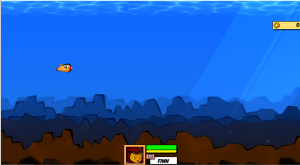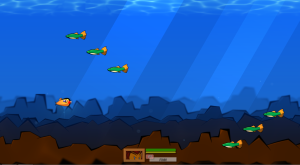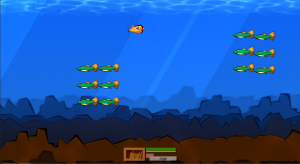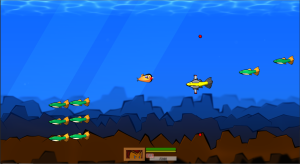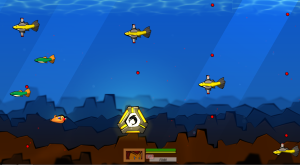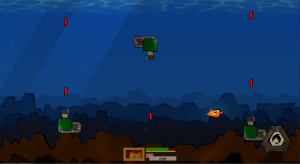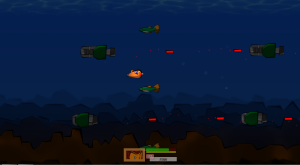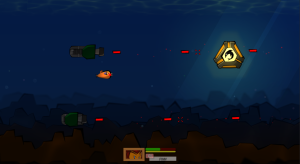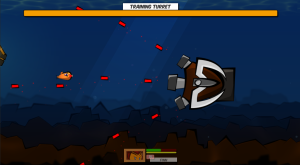In preparing for Fingeance’s demo release (out June 1st!), I’ve been updating older chunks and creating a new beginner level as an introduction to the game for newer players. If you’ll bear with me, I’d like to go over what a beginner level for Fingeance looks like.
Right in the beginning, the player is dropped into an empty ocean. The players won’t see an enemy for several seconds, and will not be in danger of taking damage even if they don’t move for quite a while. This allows the players to experiment with the controls before having to deal with any consequences. A beginner can feel free to make mistakes, spam their gadget, shoot off into nothing, and be safe from any enemy retaliation.
After the introduction, players are introduced to the simplest enemies in the game, Mini-guppies, in an easy to deal with pattern. The guppies are placed in such a way to encourage movement. Players with an understanding of the game will move downwards while shooting to hit each of the first group of guppies. Beginner players (who maybe don’t fully grasp shooting) will be able to easily avoid the guppies.
A wall of guppies follows after. These guppies are a little harder to avoid, but still easy enough to deal with. It’s a more interesting enemy pattern for all players, new or old, to go through.
20 seconds into the level, the players are introduced to the first shooting enemy, Guppy Gunners. Beginner players can avoid these by slipping between its shots. More advanced players will power through them.
Part way through the Guppy Gunner section is a Treasure Chest. This is meant as a reward for more advanced players by giving them extra scrap for avoiding or killing the gunners. Beginner players can avoid the Treasure Chest without having to worry though, as it is not a requirement.
Afterwards is an intro to the turrets. Some of the chunks in the game play out somewhat like an obstacle course, so this is a small taste of that for beginners. Note the Treasure Chest in an inconvenient location.
Here is a more advanced version of a turret pattern. The turrets are set up so that the level is split into three different lanes. Teams can split up and access each of the lanes, and can easily hit all of the upcoming enemies. Advanced players can slip between each lane too, if they’re up to the challenge.
Near the end of this level, right before the boss encounter, is another Treasure Chest. It’s a little difficult to grab for beginners, but it’s a nice heal for more experienced players before the boss.
The boss of this beginner level is another fairly simple encounter (compared to other boss encounters in the game) with a simple “target furthest player” attack pattern. An easily exploitable pattern for advanced players, and a manageable threat for beginners.
That’s one of the beginner levels we’ve got going for the demo release. The beginner levels (at least for the demo) work differently from chunks because we wanted more control over how players experienced it. Each level will be randomly chosen when the team starts the game.
This past week has actually been productive for me design wise, despite having to get through finals week (maybe it’s from all the procrastination I’ve been doing…). I’ve completed a few parts that I’ve been meaning to hash out for a while, and am now currently working on the level design for Fingeance. I realize that we haven’t gone over how levels will work in the game though, so I think I should elaborate before I go any further.
Level design in our game works fairly differently from other shoot ’em ups. Since a large focus is put on replayability and adaption in our design philosophies, we’ve established a level system that allows each playthrough to be unique, but not by the use of procedural generation. Levels are made out of several different small instances that last from 10-30 seconds (we call them “chunks”), with scattered minibosses and an end boss. This allows us to create experiences within the game that feel like full polished levels, but still have that random generation feel that is standard in most roguelikes. Some of the best chunks in the game have novel encounters you’ll recognize with experience, and because each session gives you different parts to play with, the encounters will still feel fresh.
With all that said, I’m working on improving the quality of some of the older chunks and levels right now. Early in the process, I looked to classic 2D platformers (Super Mario and the like) to help guide me. I would create chunks that introduced a gameplay aspect and build on it. I realized though that this strategy makes the level way too long, and slows down the pace of the game significantly. I’ve changed my strategy to creating shorter instances with more action inside, making a level more hectic but more fun too!
I’ll be sure to let you all know how the process is coming along next week. See you then!

